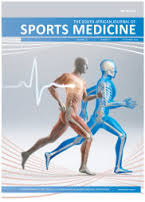Physical performance analysis of elite soccer players during the extra-time periods of the 2016 UEFA Euro Championship
DOI:
https://doi.org/10.17159/2078-516X/2018/v30i1a4842Abstract
Background: Despite the importance of extra-time in determining success in the knockout stages of soccer tournaments, there remains scant information on the physical demands of extra time on elite players.
Methods: This study investigated the physical performance profiles of all soccer players (N=59) who completed four matches that went to extra time at the 2016 UEFA Euro Championship. Players were categorised as follows: central defenders (CDs), wide defenders (WDs), central midfielders (CMs), wide midfielders (WMs), and attackers (ATs). Match activities were captured using a validated camera tracking system (InStat®).
Results: The findings showed that total distances covered by players during matches consistently decreased by 13% from the first half of the game (112.79±10.17 m) to extra time (103.17±6.39 m). The reduction of the total distance covered, especially in high-intensity running (i.e., high-speed running and sprinting), was more apparent in ATs than players in other positions.
Conclusion: Intervention strategies needed to sustain soccer players’ physical performance during extra-time periods and of post-match recovery modalities warrant further investigation.
Downloads
Downloads
Published
Issue
Section
License
Copyright (c) 2018 South African Journal of Sports Medicine

This work is licensed under a Creative Commons Attribution 4.0 International License.
The South African Journal of Sports Medicine reserves copyright of the material published. The work is licensed under a Creative Commons Attribution 4.0 (CC BY 4.0) International License. Material submitted for publication in the South African Journal of Sports Medicine is accepted provided it has not been published elsewhere. The South African Journal of Sports Medicine does not hold itself responsible for statements made by the authors.
How to Cite
- Abstract 5504
- PDF 5112
Metrics

- Citations
- Citation Indexes: 11
- Usage
- Full Text Views: 134
- Abstract Views: 24
- Captures
- Readers: 6





.png)